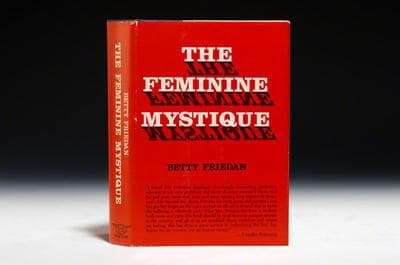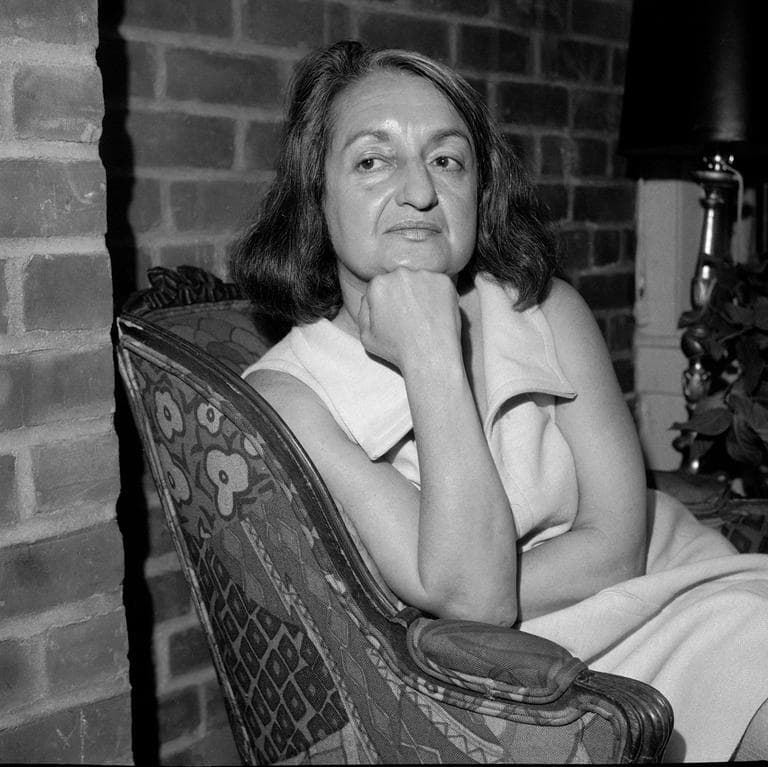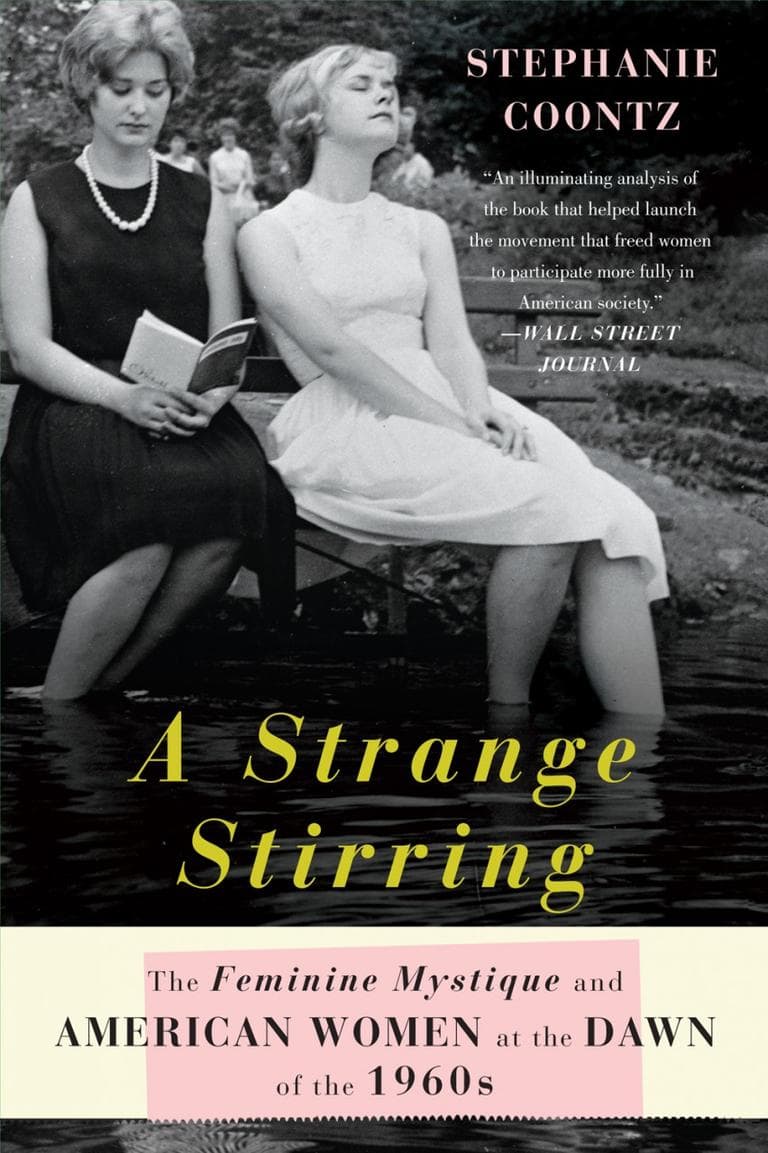Advertisement
50 Years After 'Feminine Mystique,' U.S. Behind On Family-Friendly Policies

Betty Friedan's "The Feminine Mystique" was published 50 years ago today. The book became a bestseller and is widely credited with launching a new phase of the women's movement.
Historian Stephanie Coontz says the book often surprises today's readers because it has few real, concrete political proposals. Instead, Friedan focused on changing the personal consciousness of women and men.

Coontz writes in her book "A Strange Stirring: The Feminine Mystique and American Women at the Dawn of the 1960s" (excerpt below) that Friedan did not hate men and she was not anti-marriage.
And Friedan's recommendations to women who wanted more fulfillment are the type of things you might hear today from conservative Republican women - volunteering, for example.
Cootz writes that Friedan's ideas have largely succeeded - both women and men want greater gender equality and shared family responsibility.
But even as Americans' ideas about the roles of men and women have changed dramatically, the U.S. is falling behind in laws that help couples achieve those goals.
Almost every developed country offers more time off for child care, more limits on work time and more help financially and educationally with raising children.
Did you ever read "The Feminine Mystique"? Where do you think we are on gender equality, 50 years after its publication? Let us know on our Facebook page.
Advertisement
- New York Times: Why Gender Equality Stalled
- Washington Post: Why Mad Men is TV's Most Feminist Show
____Book Excerpt: A Strange Stirring:
By: Stephanie Coontz____

NEARLY HALF A CENTURY AFTER ITS PUBLICATION, BETTY FRIEDAN’S 1963 best seller, The Feminine Mystique, still generates extreme reactions, both pro and con. In 2006, it was ranked thirty-seventh on a list of the twentieth century’s best works of journalism, compiled by a panel of experts assembled by New York University’s journalism department. But when the editors of the right-wing magazine Human Events compiled their own list of “the ten most harmful books of the nineteenth and twentieth centuries” in 2007, they put The Feminine Mystique at number seven—not far below Hitler’s Mein Kampf.
The Feminine Mystique has been credited—or blamed—for destroying, single-handedly and almost overnight, the 1950s consensus that women’s place was in the home. Friedan’s book “pulled the trigger on history,” in the words of Future Shock author Alvin Toffler. Her writing “awakened women to their oppression,” according to a fellow leader of the National Organization for Women, which Friedan helped establish a few years after The Feminine Mystique hit the best-seller list. Following Friedan’s death at age eighty-five in February 2006, dozens of news accounts reported that The Feminine Mystique ignited the women’s movement, launched a social revolution, and “transformed the social fabric” of the United States and countries around the world.
Opponents of the feminist movement are equally convinced that The Feminine Mystique revolutionized America, but they believe the book changed things for the worse. Prior to Betty Friedan, wrote one author, middle-class women “were living in peace in what they considered to be a normal, traditional, worthwhile lifestyle.” Since The Feminine Mystique, “life has never been the same.” In her 2006 book, Women Who Made the World Worse, National Review’s Kate O’Beirne complained that Friedan persuaded women that “selfless devotion was a recipe for misery.” Laura Schlessinger, of the Dr. Laura radio show, has charged that The Feminine Mystique’s disparagement “of so-called ‘women’s work’ . . . turned family life upside down and wrenched women from their homes.” And Christina Hoff Sommers of the American Enterprise Institute wrote in September 2008 that although The Feminine Mystique was correct in pointing out that postwar America took the ideal of femininity “to absurd extremes,” the book was also the source of “modern feminism’s Original Sin”—an attack on stay-at-home motherhood. Friedan’s book “did indeed pull the trigger on history,” Sommers concludes, but in doing so, she “took aim at the lives of millions of American women.”

Even people who have never read the book often react strongly to its title. In addition to interviewing people who had read The Feminine Mystique when it first came out, I asked others who had never read it to tell me what they knew about it. Their responses were surprisingly specific and vehement. The book was “full of drivel about how women had been mystified and tricked into being homemakers,” opined one woman. Another reported that the book explained how women’s sexuality had been controlled through the ages and assured me that Friedan had called for an end to marital rape and sexual harassment—ideas that do not appear anywhere in the book’s 350-plus pages. The grandmother of a student of mine insisted that this was the book that “told women to burn their bras.” Another student’s mother told her that The Feminine Mystique documented how women in the 1950s were excluded from many legal rights and paid much less than men—although in fact the book spends very little time discussing legal and economic discrimination against women.
Interestingly, many women I talked with were initially sure they had read The Feminine Mystique, only to discover in the course of our discussions or correspondence that they actually had not. When they tried to explain the gap between what they “remembered” and what I told them the book actually said, they usually decided that the title had conjured up such a vivid image in their minds that over time they had come to believe they had read it.
As a matter of fact, I was one such person. I first heard of The Feminine Mystique when I was an undergraduate at the University of California at Berkeley in 1964. But I didn’t hear about it from “Berkeley radicals.” Instead, it was my mother, a homemaker in Salt Lake City, Utah, who told me about it. She had attended the University of Washington at the end of the 1930s and married my father in the early 1940s. While Dad was away during World War II, she had done her part for the war effort, working in a shipyard. After the war ended, she quit work to follow my dad around the country as he went to college on the GI Bill, attended graduate school, and established himself in his career.
Mom spent most of the 1950s raising my sister and me. But by the early 1960s, with me away at college and my sister in junior high school, Mom began to get involved in civic activities. Soon she took a paying part-time job as executive secretary of a community group.
Once a week she would call me at college and we would fill each other in on what we were doing and thinking. At one point she asked anxiously whether I thought she could handle going back to school to get her master’s degree. At other times she proudly detailed her most recent accomplishments. Once she recounted how bored, lonely, and insecure she had felt as a housewife. The cause, she had recently discovered, was that she had succumbed to an insidious “feminine mystique,” which she had recognized only when she read this new book by Betty Friedan.
“Do you know that sociologists misrepresent research to make women feel guilty if they aren’t completely happy as full-time housewives?” she asked. Wasn’t it scandalous that when a woman expressed aspirations for anything else in her life, psychiatrists tried to make her think she was sexually maladjusted? Was I aware that advertisers manipulated women into thinking that doing household chores was a creative act, and had housewives spending more time on it than they really needed to? “They can make a cake mix that tastes perfectly fine if you just add water. But the box tells us to add an egg so housewives will feel we’re actually baking!”
I remember listening to my mother’s grievances with a certain amount of impatience, feeling that they were irrelevant to my own life. My friends and I certainly weren’t going to be just housewives. Looking back, I am ashamed to admit that at the time I believed it was largely a woman’s own fault if she wasn’t strong enough to defy social expectations and follow her dreams. But it is even sadder to realize, as I did while conducting interviews for this book, that most of these women also believed their problems were their own fault.
I was vaguely aware that women had once organized a long, hard fight to win the right to vote, but that was in the distant past. Far from identifying with other women, I—like many other independent women my age—prided myself on being unlike the rest of my sex. In the memorable words of feminist activist and author Jo Freeman, we grew up “believing there were three sexes: men, women, and me.” We knew we didn’t want to follow in our mothers’ footsteps, but it did not yet occur to us that it might require more than an individual decision to chart our own course, that we would need an organized movement to pry open new opportunities and overturn old prejudices. The only movement that really meant something to us in the early 1960s was the burgeoning civil rights movement.
It took a few years for female civil rights activists such as myself to begin to see that we too were subject to many societal prejudices because of our sex. Only gradually, quite a while after the book had inspired my mother and many other housewives, did my friends and I begin to use “the feminine mystique” as a useful label to describe the prejudices and discrimination we encountered.
In fact, it was soon so useful that at some point, long ago, the phrase “feminine mystique” became such a part of my consciousness that I was absolutely sure I had read Friedan’s book. So when JoAnn Miller, an editor at Basic Books, suggested that I write a biography not of Betty Friedan the author, but of the book she wrote, I jumped at the chance. I was certain that rereading this groundbreaking book would be an educational and inspiring experience. I also decided that I would assign The Feminine Mystique to my students to gauge how they would react to a book that had been so influential to an earlier generation.
After only a few pages I realized that in fact I had never read The Feminine Mystique, and after a few chapters I began to find much of it boring and dated. As it turned out, so did my students. The book seemed repetitive and overblown. It made claims about women’s history that I knew were oversimplified, exaggerating both the feminist victories of the 1920s and the antifeminist backlash of the 1940s and 1950s.
I was interested by Friedan’s account of how she had “lived according to the feminine mystique as a suburban housewife” and only gradually come to see that something was wrong with the way she and other American women were being told to organize their lives. But although the story of her journey of discovery was engrossing, her generalizations about women seemed so limited by her white middle-class experience that I thought the book’s prescriptions for improving women’s lives were irrelevant to working-class and African-American women.
And Friedan’s warnings about “the homosexuality that is spreading like a murky smog over the American scene” sounded more like something that would come out of the mouth of a right-wing televangelist than a contemporary feminist. So too did her alarmist talk about permissive parenting, narcissistic self-indulgence, juvenile delinquency, and female promiscuity.
My initial reaction became more negative when I went on to discover that Friedan had misrepresented her own history and the origins of her ideas. Checking her account of the publishing history and reception of The Feminine Mystique against the actual historical record, I discovered disturbing discrepancies. I was put off by her egotism, which even her most ardent admirers have acknowledged was “towering,” and disliked her tendency to pump up her own accomplishments by claiming that the media, and even her own publisher, were almost uniformly hostile to her views.
I was also indignant that Friedan portrayed all women in that era as passive and preoccupied with their homes. What about the African- American women who had led civil rights demonstrations and organized community actions throughout the 1950s and early ’60s, standing up to racist mobs and police brutality—women such as Rosa Parks, Daisy Bates, Ella Baker, Septima Clark, Dorothy Height, and so many more? What about the female labor organizers of the 1950s or the thousands of mothers who risked arrest in 1959 and 1960, pushing their children in strollers, to protest the mandatory air raid drills that they believed taught Americans to accept the possibility of nuclear war?
But gradually my appreciation of the book grew, as I talked to people who had read the book when it was first published in the early 1960s, went through the letters Friedan received after its publication, and revisited the era in which Friedan wrote. Paradoxically, the less relevant the book seemed now, the more grateful I became to Friedan for reaching out to the many women who, like my mother, had found it a revelation at the time—women who told me over and over that The Feminine Mystique transformed their lives, even that it actually “saved” their lives, or at least their sanity. A half century after they read the book, many of the women I talked to could still recall the desperation they had felt in the late 1950s and early 1960s, and their wave of relief when Friedan told them they were not alone and they were not crazy.
Most of the women who wrote to Friedan after her book was published in 1963 and became a paperback best seller in 1964, and most of the nearly two hundred people who took part in my own surveys, were the wives and daughters of families that had lived through World War II. They—or their parents—were born between about 1915 and the late 1930s. Memories of the Great Depression were still vivid in their family culture. They—or their parents, older siblings, or husbands—had experienced the hardships and the solidarities of World War II. The older ones had raised their families in the 1940s or the 1950s and the younger ones had been teenagers in the 1950s.
In the ensuing years, some authors have labeled the older members of this group as “the greatest generation.” Others have called it the “silent generation.” Both these labels apply to the collective experiences of the men, as soldiers in World War II or as citizens during the Cold War and the Korean War; they have little relevance to the collective experiences of the women of that era.
The women who found solace in Friedan’s ideas would not have called themselves, or their mothers, members of the greatest generation. Most felt they were the beneficiaries of their fathers’ or husbands’ hard work, and many wondered whether they had done anything to deserve the gains their families made in the postwar era. When they did not feel fulfilled in those families, they blamed themselves for being ungrateful or inadequate.
It is not your fault, Friedan told them, that you feel trapped and discontented. The fault lies with the way society has denigrated and wasted your capacities. Not only will you be happier yourselves, but you will be better wives and mothers if you are recognized as individuals with your own social, intellectual, and creative needs. The title of Friedan’s 1960 Good Housekeeping article that previewed her argument in The Feminine Mystique put it simply: “Women Are People Too.”
Strange though it may seem today, many women in the 1950s and early 1960s had never heard anyone say that out loud. Women were wives and mothers. A few, they knew, were also heroines, brave souls like the female spies who risked their lives for the Allies in World War II. But the idea that an ordinary woman could be a person in her own right, in addition to being a wife and mother, seemed completely new to many women.
Friedan told these women that their inability to imagine a fuller, more complete life was the product of a repressive postwar campaign to wipe out the memory of past feminist activism and to drive women back into the home. As a historian, I knew her argument ignored the challenges to the feminine mystique that already existed in the 1950s. But as I interviewed women for this book and read more about the cultural climate of that era, I came to believe that Friedan was correct in suggesting that there was something especially disorienting—“something paralyzing,” as one of the women I interviewed put it—about the situation confronting women at the dawn of the 1960s. Freudian pronouncements about the natural dependence and passivity of females and the “sickness” of women who were attracted to careers may have coexisted with sympathetic assurances that women were in fact capable and did deserve equality. But such assurances only made it harder for women to figure out whether anyone besides themselves was to blame for their feelings of inadequacy.
Friedan captured a paradox that many women struggle with today. The elimination of the most blatant denials of one’s rights can be very disorienting if you don’t have the ability to exercise one right without giving up another. The lack of support for women’s ability to exercise both rights at once forces them to choose half of what they really want, and to blame themselves if that half fails to satisfy their needs. Today many women find this out when they try to balance motherhood and work. In Friedan’s time, many women discovered this problem when they fell in love with a man.
The choices women were forced to make in the 1950s were far more starkly posed than ours are today. Contemporary women may resent the pressure to be a superwoman and “do it all,” but in that era the prevailing wisdom was that only a superwoman could choose to do anything with her life in addition to marriage and motherhood, and that such superwomen were few and far between. Yes, pundits admitted, a woman could sometimes achieve a brilliant career or create a great work of art. But before she tried, journalist Dorothy Thompson warned her readers in the Ladies’ Home Journal, she had better make sure she was a “genius,” because if she ended up doing something only ordinary, or “second-rate,” she would be wasting the chance to raise a “first-rate” child. One of the most touching letters to Friedan that I read came from a woman who thanked Friedan for delivering her from the tremendous guilt she had felt because she enjoyed working “not in a big business, achieving miracles of economics or science” but at a mundane job that nevertheless made her feel “needed, able, and secure.”
So much has changed since Friedan wrote. At that time, many women felt they had too few challenges. Now most of us feel we have too many. At that time, many women believed their minds and talents were being wasted but felt guilty if they wanted to do more. Now we often feel used up by the demands on our time and talents but feel guilty when we want to do less, either at work or at home.
And yet three themes still resonate today. One is Friedan’s forceful analysis of consumerism. “The sexual sell,” as she termed it, is even more powerful than in the 1950s, although it is now most destructive for girls and teens rather than for housewives. Second is Friedan’s defense of meaningful, socially responsible work—paid or unpaid—as a central part of women’s identity as well as men’s. And third is her insistence that when men and women share access to real meaning in their public lives, they can build happier relationships at home as well. In this respect, we now know that Friedan’s predictions came closer to capturing the reality of twenty-first-century marriage trends and gender relations than more pessimistic prophecies about the supposed “battle of the sexes” that would result if women gained equality.
We still haven’t fully figured out how to combine a loving family life with a rewarding work life. But The Feminine Mystique reminds us of the price women pay when we retreat from trying to resolve these dilemmas or fail to involve men in our attempts.
Guest:
- Stephanie Coontz, professor of family history at The Evergreen State College and author of "A Strange Stirring: The Feminine Mystique and American Women at the Dawn of the 1960s."
This segment aired on February 19, 2013.